Abstract
The value of hypertonic media in the detection of bacteremia and fungemia is controversial, since prior clinical trials have yielded conflicting results with different media. Earlier, we showed that the addition of 10% sucrose to supplemented peptone broth at a 1:10 ratio of blood to broth yielded better recovery of Staphylococcus epidermidis, the Enterobacteriaceae, Pseudomonas aeruginosa, and yeasts. To evaluate the effect of 10% sucrose on blood cultured at a 1:5 ratio, we compared the yield and speed of detection of clinically important microorganisms from adult patients in 5,839 blood samples cultured in supplemented peptone broth with 0.03% sodium polyanetholesulfonate with and without 10% sucrose. The atmosphere of incubation (open venting units), 1:5 ratio of blood to broth, and methods of processing were the same for both bottles. Recovery of facultative gram-positive (P less than 0.02) and gram-negative (P less than 0.02) bacteria was improved, but the recovery of anaerobic gram-negative bacteria was both reduced (P less than 0.01) and delayed (P less than 0.02) by sucrose. The total yield of microorganisms including fungi, however, was increased with sucrose. The effect of sucrose on blood cultures appears to depend on the ratio of blood to broth as well as on the medium used and strains of microorganisms encountered.
Full text
PDF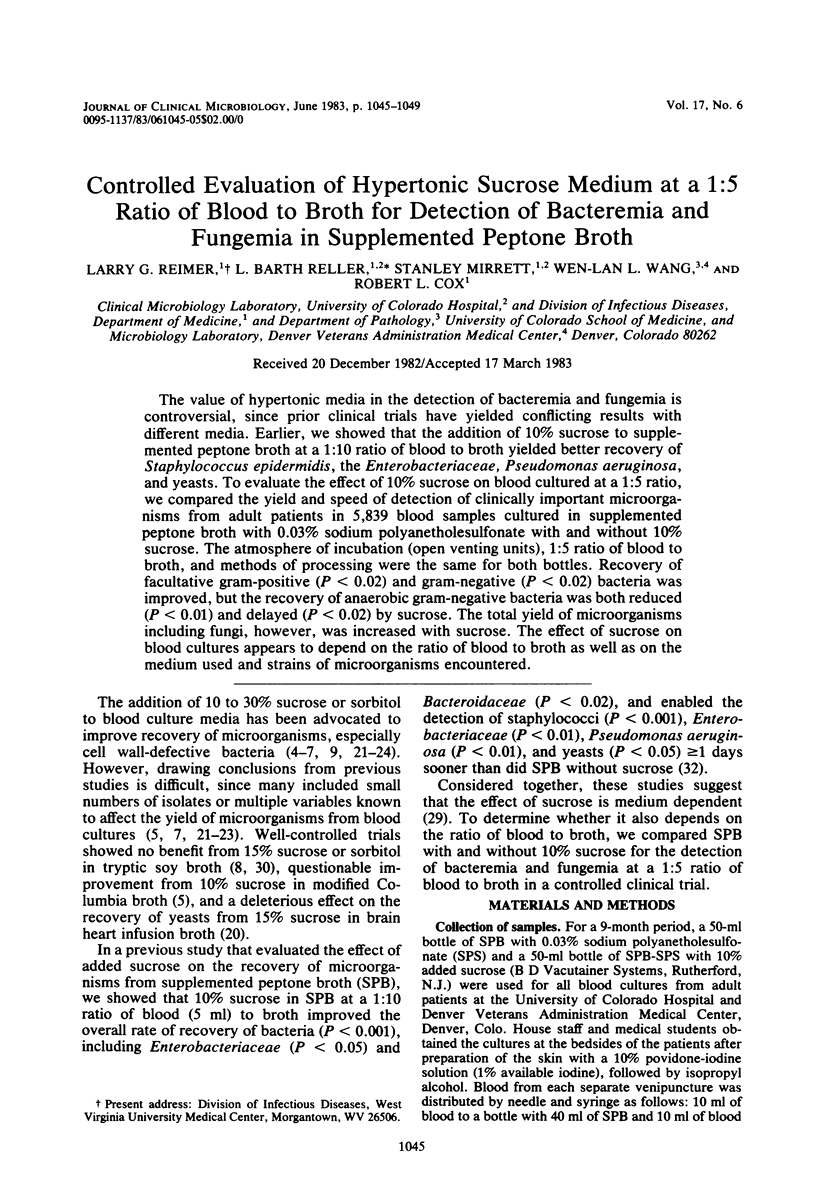
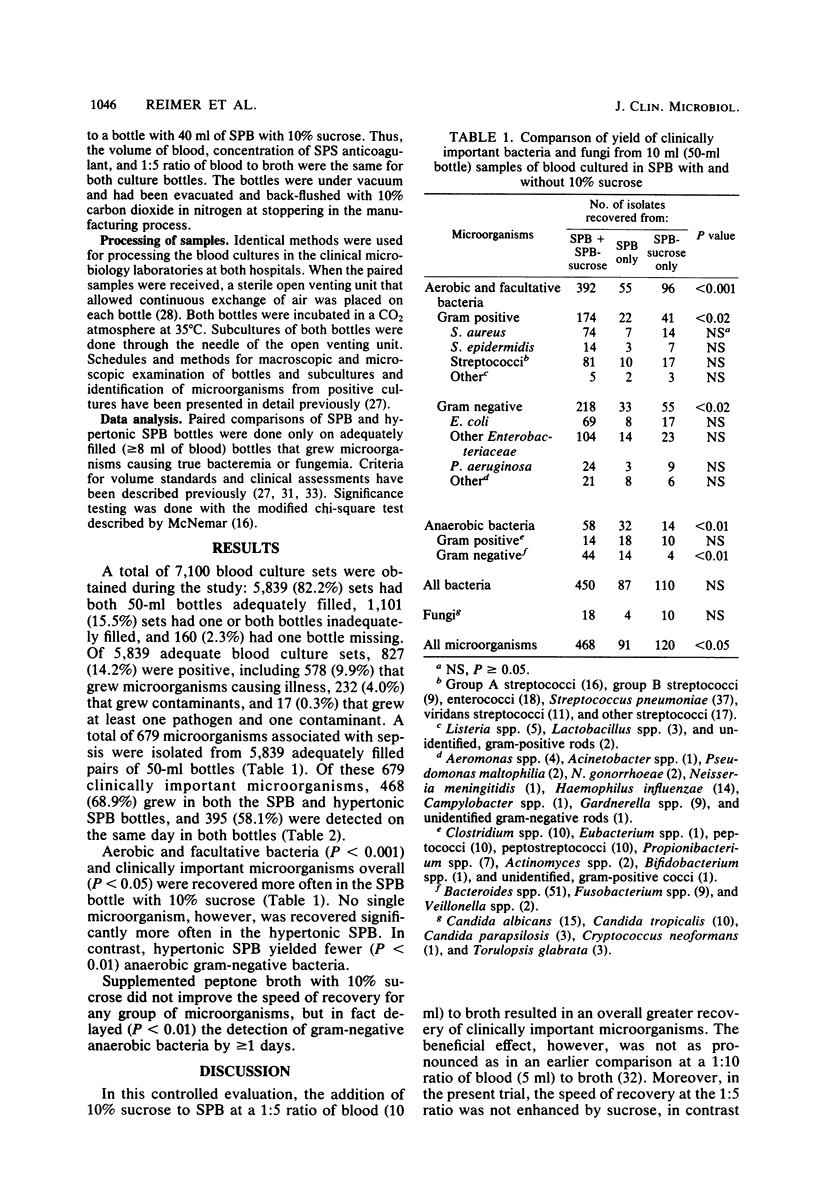
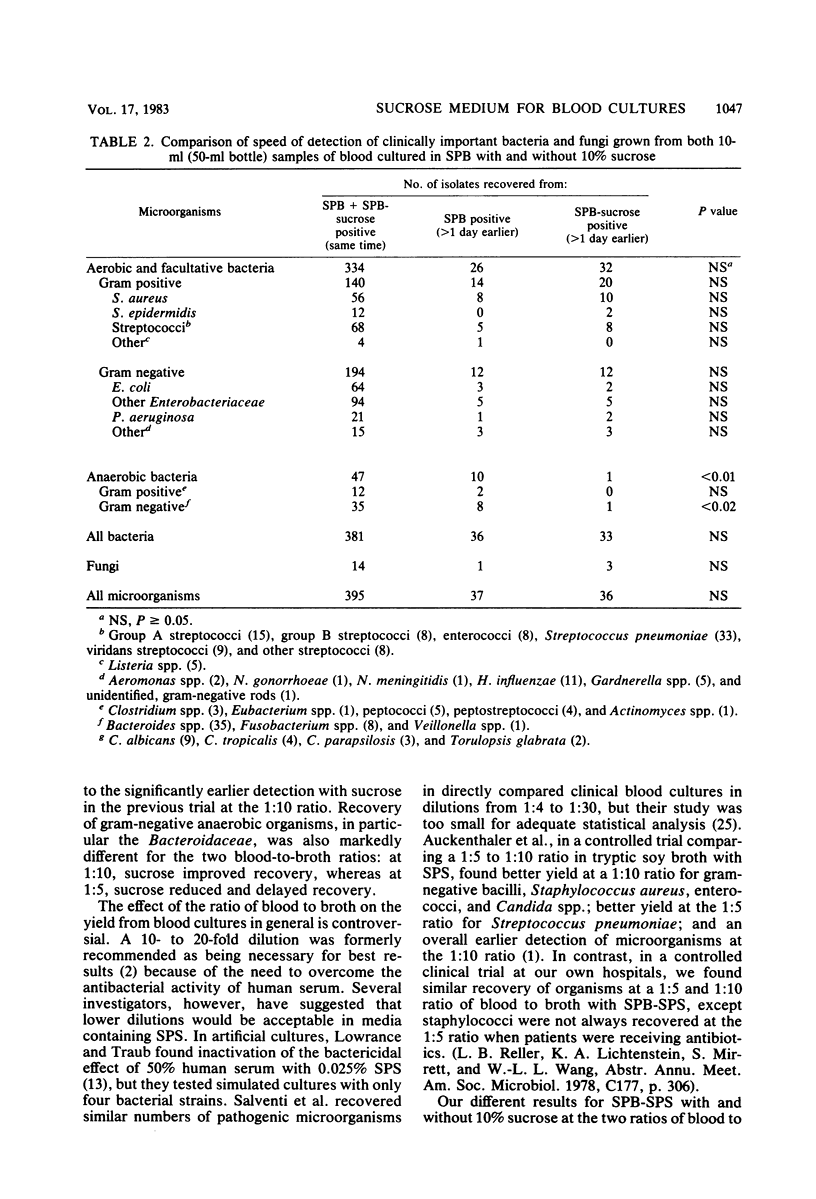
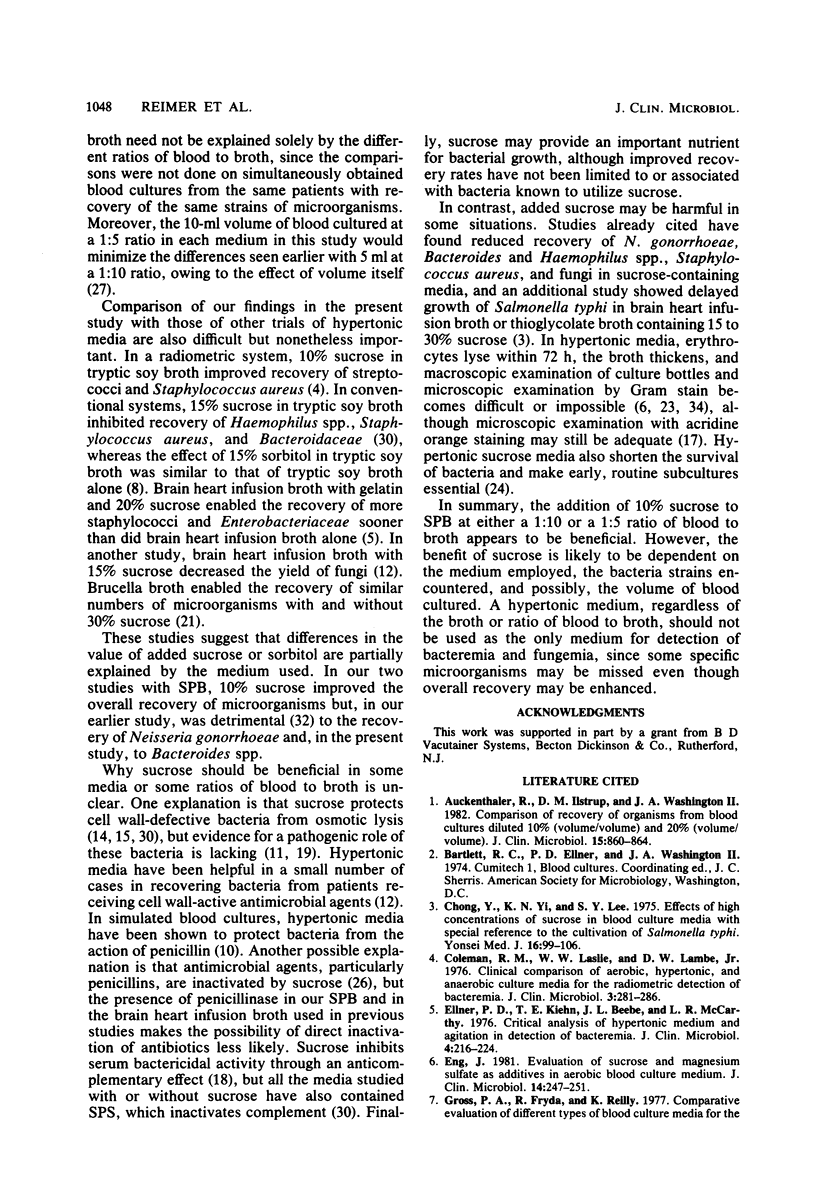
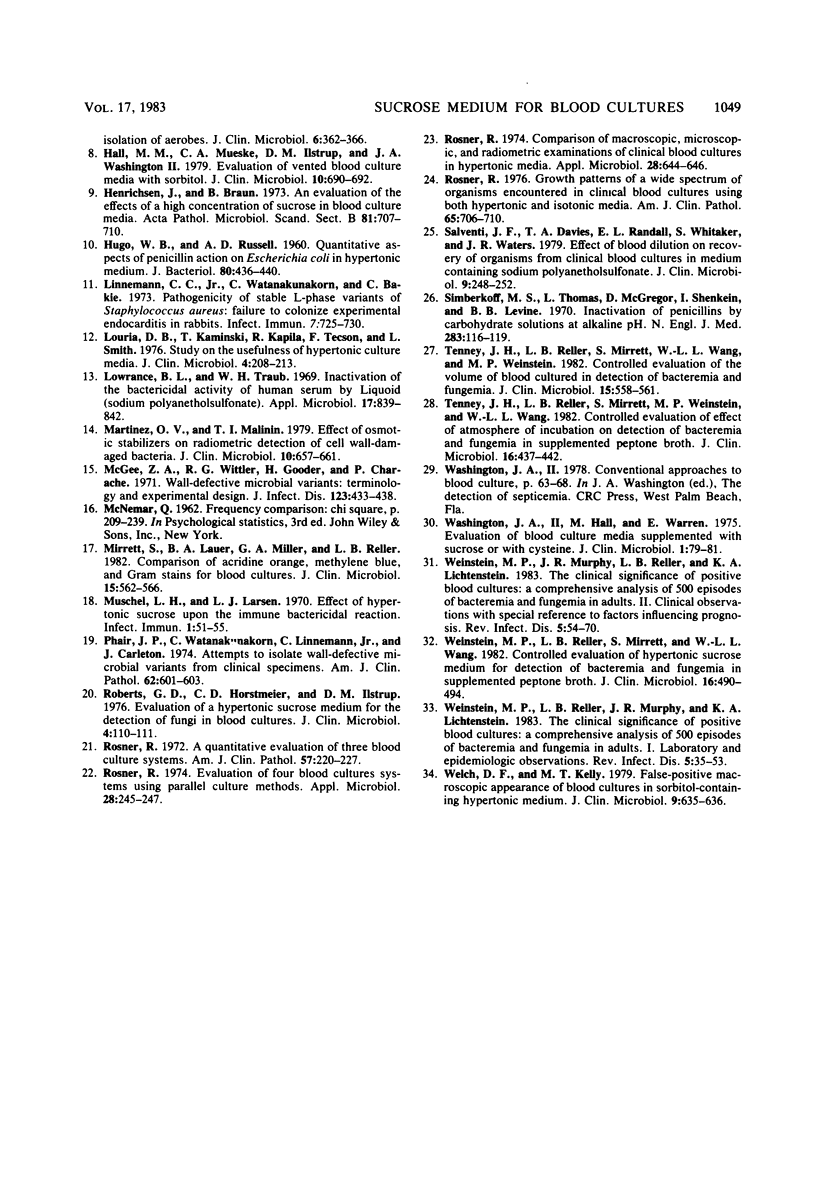
Selected References
These references are in PubMed. This may not be the complete list of references from this article.
- Auckenthaler R., Ilstrup D. M., Washington J. A., 2nd Comparison of recovery of organisms from blood cultures diluted 10% (volume/volume) and 20% (volume/volume). J Clin Microbiol. 1982 May;15(5):860–864. doi: 10.1128/jcm.15.5.860-864.1982. [DOI] [PMC free article] [PubMed] [Google Scholar]
- Chong Y., Yi K. N., Lee S. Y. Effects of high concentrations of sucrose in blood culture media with special reference to the cultivation of Salmonella typhi. Yonsei Med J. 1975;16(2):99–106. doi: 10.3349/ymj.1975.16.2.99. [DOI] [PubMed] [Google Scholar]
- Coleman R. M., Laslie W. W., Lambe D. W., Jr Clinical comparison of aerobic, hypertonic, and anaerobic culture media for the radiometric detection of bacteremia. J Clin Microbiol. 1976 Mar;3(3):281–286. doi: 10.1128/jcm.3.3.281-286.1976. [DOI] [PMC free article] [PubMed] [Google Scholar]
- Ellner P. D., Kiehn T. E., Beebe J. L., McCarthy L. R. Critical analysis of hypertonic medium and agitation in detection of bacteremia. J Clin Microbiol. 1976 Sep;4(3):216–224. doi: 10.1128/jcm.4.3.216-224.1976. [DOI] [PMC free article] [PubMed] [Google Scholar]
- Eng J. Evaluation of sucrose and magnesium sulfate as additives in aerobic blood culture medium. J Clin Microbiol. 1981 Sep;14(3):247–251. doi: 10.1128/jcm.14.3.247-251.1981. [DOI] [PMC free article] [PubMed] [Google Scholar]
- Gross P. A., Fryda R., Reilly K. Comparative evaluation of different types of blood culture media for isolation of aerobes. J Clin Microbiol. 1977 Oct;6(4):362–366. doi: 10.1128/jcm.6.4.362-366.1977. [DOI] [PMC free article] [PubMed] [Google Scholar]
- HUGO W. B., RUSSELL A. D. Quantitative aspects of penicillin action on Escherichia coli in hypertonic medium. J Bacteriol. 1960 Oct;80:436–440. doi: 10.1128/jb.80.4.436-440.1960. [DOI] [PMC free article] [PubMed] [Google Scholar]
- Hall M. M., Mueske C. A., Ilstrup D. M., Washington J. A., 2nd Evaluation of vented blood culture media with sorbitol. J Clin Microbiol. 1979 Nov;10(5):690–692. doi: 10.1128/jcm.10.5.690-692.1979. [DOI] [PMC free article] [PubMed] [Google Scholar]
- Henrichsen J., Bruun B. An evaluation of the effects of a high concentration of sucrose in blood culture media. Acta Pathol Microbiol Scand B Microbiol Immunol. 1973 Dec;81(6):707–710. doi: 10.1111/j.1699-0463.1973.tb02264.x. [DOI] [PubMed] [Google Scholar]
- Linnemann C. C., Jr, Watanakunakorn C., Bakie C. Pathogenicity of stable L-phase variants of Staphylococcus aureus: failure to colonize experimental endocarditis in rabbits. Infect Immun. 1973 May;7(5):725–730. doi: 10.1128/iai.7.5.725-730.1973. [DOI] [PMC free article] [PubMed] [Google Scholar]
- Louria D. B., Kaminski T., Kapila R., Tecson F., Smith L. Study on the usefulness of hypertonic culture media. J Clin Microbiol. 1976 Sep;4(3):208–213. doi: 10.1128/jcm.4.3.208-213.1976. [DOI] [PMC free article] [PubMed] [Google Scholar]
- Lowrance B. L., Traub W. H. Inactivation of the bactericidal activity of human serum by liquoid (sodium polyanetholsulfonate). Appl Microbiol. 1969 Jun;17(6):839–842. doi: 10.1128/am.17.6.839-842.1969. [DOI] [PMC free article] [PubMed] [Google Scholar]
- Martinez O. V., Malinin T. I. Effect of osmotic stabilizers on radiometric detection of cell wall-damaged bacteria. J Clin Microbiol. 1979 Nov;10(5):657–661. doi: 10.1128/jcm.10.5.657-661.1979. [DOI] [PMC free article] [PubMed] [Google Scholar]
- McGee Z. A., Wittler R. G., Gooder H., Charache P. Wall-defective microbial variants: terminology and experimental design. J Infect Dis. 1971 Apr;123(4):433–438. doi: 10.1093/infdis/123.4.433. [DOI] [PubMed] [Google Scholar]
- Mirrett S., Lauer B. A., Miller G. A., Reller L. B. Comparison of acridine orange, methylene blue, and Gram stains for blood cultures. J Clin Microbiol. 1982 Apr;15(4):562–566. doi: 10.1128/jcm.15.4.562-566.1982. [DOI] [PMC free article] [PubMed] [Google Scholar]
- Muschel L. H., Larsen L. J. Effect of hypertonic sucrose upon the immune bactericidal reaction. Infect Immun. 1970 Jan;1(1):51–55. doi: 10.1128/iai.1.1.51-55.1970. [DOI] [PMC free article] [PubMed] [Google Scholar]
- Phair J. P., Watanakunakorn C., Linnemann C., Jr, Carleton J. Attempts to isolate wall-defective microbial variants from clinical specimens. Am J Clin Pathol. 1974 Nov;62(5):601–603. doi: 10.1093/ajcp/62.5.601. [DOI] [PubMed] [Google Scholar]
- Roberts G. D., Horstmeier C. D., Ilstrup D. M. Evaluation of a hypertonic sucrose medium for the detection of fungi in blood cultures. J Clin Microbiol. 1976 Jul;4(1):110–111. doi: 10.1128/jcm.4.1.110-111.1976. [DOI] [PMC free article] [PubMed] [Google Scholar]
- Rosner R. A quantitative evaluation of three blood culture systems. Am J Clin Pathol. 1972 Feb;57(2):220–227. doi: 10.1093/ajcp/57.2.220. [DOI] [PubMed] [Google Scholar]
- Rosner R. Comparison of macroscopic, microscopic, and radiometric examinations of clinical blood cultures in hypertonic media. Appl Microbiol. 1974 Oct;28(4):644–646. doi: 10.1128/am.28.4.644-646.1974. [DOI] [PMC free article] [PubMed] [Google Scholar]
- Rosner R. Evaluation of four blood culture systems using parallel culture methods. Appl Microbiol. 1974 Aug;28(2):245–247. doi: 10.1128/am.28.2.245-247.1974. [DOI] [PMC free article] [PubMed] [Google Scholar]
- Rosner R. Growth patterns of a wide spectrum of organisms encountered in clinical blood cultures using both hypertonic and isotonic media. Am J Clin Pathol. 1976 May;65(5):706–710. doi: 10.1093/ajcp/65.5.706. [DOI] [PubMed] [Google Scholar]
- Salventi J. F., Davies T. A., Randall E. L., Whitaker S., Waters J. R. Effect of blood dilution on recovery of organisms from clinical blood cultures in medium containing sodium polyanethol sulfonate. J Clin Microbiol. 1979 Feb;9(2):248–252. doi: 10.1128/jcm.9.2.248-252.1979. [DOI] [PMC free article] [PubMed] [Google Scholar]
- Simberkoff M. S., Thomas L., McGregor D., Shenkein I., Levin B. B. Inactivation of penicillins by carbohydrate solutions at alkaline pH. N Engl J Med. 1970 Jul 16;283(3):116–119. doi: 10.1056/NEJM197007162830302. [DOI] [PubMed] [Google Scholar]
- Tenney J. H., Reller L. B., Mirrett S., Wang W. L., Weinstein M. P. Controlled evaluation of the volume of blood cultured in detection of bacteremia and fungemia. J Clin Microbiol. 1982 Apr;15(4):558–561. doi: 10.1128/jcm.15.4.558-561.1982. [DOI] [PMC free article] [PubMed] [Google Scholar]
- Tenney J. H., Reller L. B., Mirrett S., Weinstein M. P., Wang W. L. Controlled evaluation of the effect of atmosphere of incubation on detection of bacteremia and fungemia in supplemented peptone broth. J Clin Microbiol. 1982 Sep;16(3):437–442. doi: 10.1128/jcm.16.3.437-442.1982. [DOI] [PMC free article] [PubMed] [Google Scholar]
- Washington J. A., 2nd, Hall M. M., Warren E. Evaluation of blood culture media supplemented with sucrose or with cysteine. J Clin Microbiol. 1975 Jan;1(1):79–81. doi: 10.1128/jcm.1.1.79-81.1975. [DOI] [PMC free article] [PubMed] [Google Scholar]
- Weinstein M. P., Murphy J. R., Reller L. B., Lichtenstein K. A. The clinical significance of positive blood cultures: a comprehensive analysis of 500 episodes of bacteremia and fungemia in adults. II. Clinical observations, with special reference to factors influencing prognosis. Rev Infect Dis. 1983 Jan-Feb;5(1):54–70. doi: 10.1093/clinids/5.1.54. [DOI] [PubMed] [Google Scholar]
- Weinstein M. P., Reller L. B., Mirrett S., Wang W. L. Controlled evaluation of hypertonic sucrose medium for detection of bacteremia and fungemia in supplemented peptone broth. J Clin Microbiol. 1982 Sep;16(3):490–494. doi: 10.1128/jcm.16.3.490-494.1982. [DOI] [PMC free article] [PubMed] [Google Scholar]
- Weinstein M. P., Reller L. B., Murphy J. R., Lichtenstein K. A. The clinical significance of positive blood cultures: a comprehensive analysis of 500 episodes of bacteremia and fungemia in adults. I. Laboratory and epidemiologic observations. Rev Infect Dis. 1983 Jan-Feb;5(1):35–53. doi: 10.1093/clinids/5.1.35. [DOI] [PubMed] [Google Scholar]
- Welch D. F., Kelly M. T. Fasle-positive macroscopic appearance of blood cultures in sorbitol-containing hypertonic medium. J Clin Microbiol. 1979 May;9(5):635–636. doi: 10.1128/jcm.9.5.635-636.1979. [DOI] [PMC free article] [PubMed] [Google Scholar]


